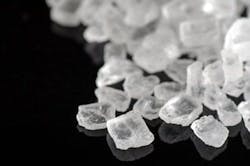Water Softening: Evaluating Efficiency
About the author: Rick Andrew is director of global business development – water systems for NSF Intl. Andrew can be reached at [email protected] or 800.673.6275.
The benefits water softeners provide in terms of preventing limescale buildup in piping and extending the life of appliances like water heaters and dishwashers are well established. However, in response to water shortages in some parts of the country, municipalities are considering restrictions or bans on water softeners, which add salt to water in the process of removing calcium and magnesium to soften it. The water softener industry has self-regulated by producing systems that use water and salt more efficiently. The next step—independent, third-party testing and certification to confirm the efficiency of these products—adds assurance for both regulators and consumers.
Environmental Considerations
In the Southwest, where droughts are becoming increasingly frequent, water generally comes from Lake Mead, which serves municipalities throughout California, Nevada and Arizona. Water travels a long way from Lake Mead along the Colorado River to reach end users, dissolving minerals and suffering evaporative losses along the way, resulting in high total dissolved solids (TDS). This means water supplies in the Southwest that are fed by Lake Mead can be three times higher in TDS (1,000 versus 300) than in other areas of the country, so adding salt to the water supply as a result of softening is a valid concern in terms of total TDS level.
In these areas, softening systems that use as little water and salt as possible are especially important to the marketplace and regulators.
Industry Response
There are many ways to minimize the salt and water use of a softener system through system design and operation. Factors affecting salt efficiency include salt dose, brine flow rate, brine flow direction and reserve setting.
With these adjustments, the industry argues that the benefits of water softeners outweigh the extra salt introduced to the water system, because high TDS values and hardness cause quicker buildup of limescale upon heating of water, which causes appliances such as hot water heaters and dishwashers to run less efficiently (using more energy) and eventually stop working (generating landfill and replacement costs).
In addition, the industry is focusing on replacing older, time clock-based regeneration technology with modern demand-initiated regeneration (DIR), where a flowmeter tracks how much water is being used in a specific household to determine a specific gallon amount of use before initiating regeneration. Dealers also can install water softener feeds only to certain taps and appliances and not soften the water going to outside taps, further minimizing the amount of water softened.
New technologies, such as magnets and electromagnets wrapped around pipe, media-based systems, electrodeionization systems and other physical devices, also are being developed as alternatives to systems that use salt. However, their operating principle is to prevent limescale buildup by keeping calcium and magnesium from sticking to pipe—they do not actually remove these minerals, keeping water hard. And, as of now, there is not an agreed-upon industry standard test method to evaluate their effectiveness, thus leaving the support for the performance of these technologies as anecdotal or situational.
Value of Certification
In the current marketplace and regulatory landscape, the ability to demonstrate that a cation exchange water softener makes efficient use of salt and water is critical. This is where standards come into play. Testing to third-party standards assures consumers that systems perform as they claim and provides specific usage data to regulators. The only American National Standard that provides efficiency rating certification in the U.S. is NSF/ANSI Standard 44: Residential Cation Exchange Water Softeners. Water softeners certified as efficient are accepted in all areas of the country, not just those with water shortage or quality concerns.
Test Criteria
Under NSF/ANSI 44, water softeners are tested for efficiency based on how much salt and water they use to regenerate. Salt efficiency is the measurement of how much salt a water softener uses to remove hardness from water. The efficiency is calculated in terms of how many grains of hardness are removed per pound of salt used when regenerating the system using the unit grains per pound. Water efficiency is calculated by how much water the softener uses to regenerate and how much hardness is removed given the amount of water required for regeneration, generally using one of two units: gallons per regeneration or gallons of regeneration water per 1,000 grains of hardness removed.
Softeners that are tested and certified for efficiency to NSF/ANSI 44 must be DIR systems that meet the following criteria:
• A salt efficiency of at least 3,350 grains per pound of salt used for regeneration (or, rated for use in California, at least 4,000 grains per pound); and
• A water efficiency of 5 gal of regeneration water (or less) per 1,000 grains of hardness removed.
The efficiency rating criteria are based on a thorough engineering analysis of well-performing systems and industry standards. The NSF/ANSI standard includes criteria from WQA S-100, which was harmonized into NSF/ANSI 44 in 1999.
Efficiency is confirmed through laboratory testing of softeners per the detailed methods described in NSF/ANSI 44, with careful and accurate analytical methods and repeated softening runs required to establish these values with a high degree of confidence.
Other Certification Criteria
Aside from efficiency ratings, certification to NSF/ANSI 44 involves testing to verify that the materials that come into contact with drinking water do not leach harmful chemicals into the water (per the requirements of NSF/ANSI Standard 61) as well as the structural performance of the unit (including the materials, design and fabrication quality of the complete water treatment system) and the accuracy of all installation, operation and maintenance instructions.
If a DIR water softener also reduces radium and barium, these claims can be verified through certification to NSF/ANSI 44 as well.
Download: Here
